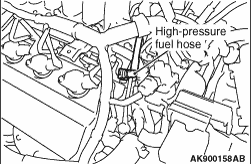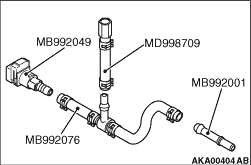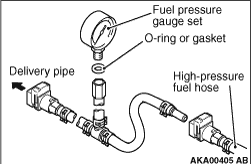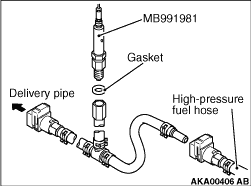|
|
1.Release residual pressure from the fuel pipe line to prevent fuel gush out (Refer
to  ). ).
|

|
2.Disconnect the high-pressure fuel hose at the delivery pipe side.
|

|
3.Assemble the special tool called injector test set (MB992076) as shown in the figure.
(1)
Remove the injector installation adapter from the hose. Remove another hose together
with the adapter and remove the adopter from the remaining hose.
(2)
To the hose ends from which each adapter is removed, attach the special tool quick
connector (MB992049) and special tool hose adapter (MB992001).
(3)
Remove the nipple of the bolt of the special tool hose adapter (MD998709).
(4)
Install the special tool prepared in the procedure (3) to the nipple that was removed
together with hose in the procedure (1)
4.Attach the special tool between the delivery pipe and fuel pipe pressure hose.
|

|
<Where the fuel pressure gauge is used>
- Attach the fuel pressure gauge on the special tool for measuring the fuel pressure via
an appropriate O-ring or gasket.
|

|
<Where the fuel pressure gauge set is used>
- Attach the special tool fuel pressure gauge set (MB991981) on the special tool for measuring
the fuel pressure via an appropriate gasket.
- Connect the leads from the fuel pressure gauge set to the power supply (cigarette
lighter socket) and special tool vehicle communication interface (V.C.I.) (MB991824).
| caution |
Connection and disconnection of M.U.T.-III should be always
performed with the ignition switch turned to the LOCK (OFF) position.
|
5.Connect the M.U.T.-III to the diagnosis connector.
6.Turn the ignition switch to the ON position. (But do not start the engine.)
7.Select "Item No. 09" of the M.U.T.-III actuator test to drive the fuel pump.Verify
there is no leakage from each section with the fuel pressure being applied.
8.Finish the actuator test or turn the ignition switch to the LOCK (OFF) position.
9.Start the engine and run at idle.
10.Measure the fuel pressure while the engine is running at idle.
Standard value: Approximately 324 kPa
11.Check to see that fuel pressure at idle does not drop even after the engine has been
raced several times.
12.If any of fuel pressure measured in steps 10 and 11 is out of specification, troubleshoot
and repair according to the table below.
Symptom
|
Probable cause
|
Remedy
|
- Fuel pressure is
too low.
- Fuel pressure drops after racing.
|
Clogged fuel filter
|
Replace the fuel filter.
|
Fuel leaking to the return side due to poor seating of the fuel regulator valve
in the fuel pressure regulator or the settled spring.
|
Replace fuel pressure regulator
|
Low fuel pump delivery pressure
|
Replace fuel pump.
|
Fuel pressure is too high.
|
Binding valve in fuel pressure regulator
|
Replace fuel pressure regulator
|
13.Stop the engine and check change of fuel pressure gauge reading.Normal if the reading
does not drop within 2 minutes.If it does, observe the rate of drop and troubleshoot and repair
according to the table below.
Symptom
|
Probable cause
|
Remedy
|
Fuel pressure drops gradually after engine is stopped
|
Leaky injector
|
Replace injector.
|
Leaky fuel regulator valve seat
|
Replace fuel pressure regulator
|
Fuel pressure drops sharply immediately after engine is stopped
|
Check valve in fuel pump is held open
|
Replace fuel pump.
|
14.Release residual pressure from the fuel pipe line.
| caution |
Cover the hose connection with rags to prevent splash of fuel that could be
caused by some residual pressure in the fuel pipe line.
|
15.Remove the special tool from delivery pipe.
16.Replace high-pressure fuel hose to delivery pipe.
17.Check for any fuel leaks by following the procedure in step 7.
18.Disconnect the M.U.T.-III.
|
 ).
). ).
).
